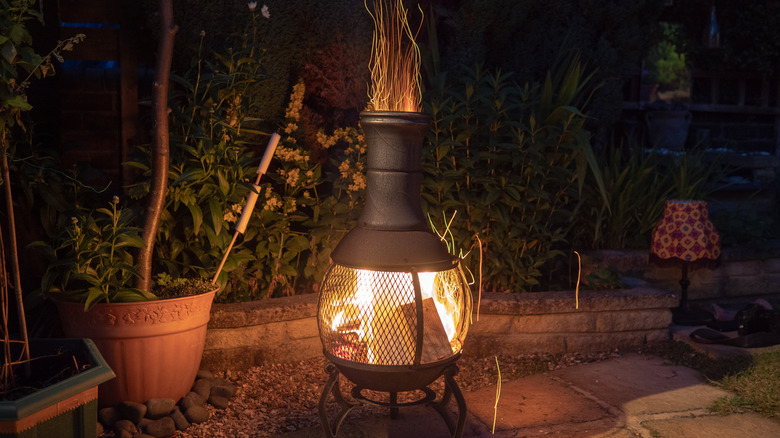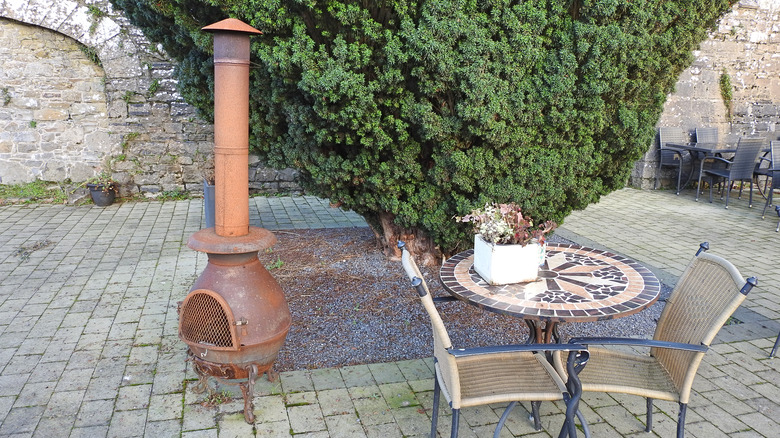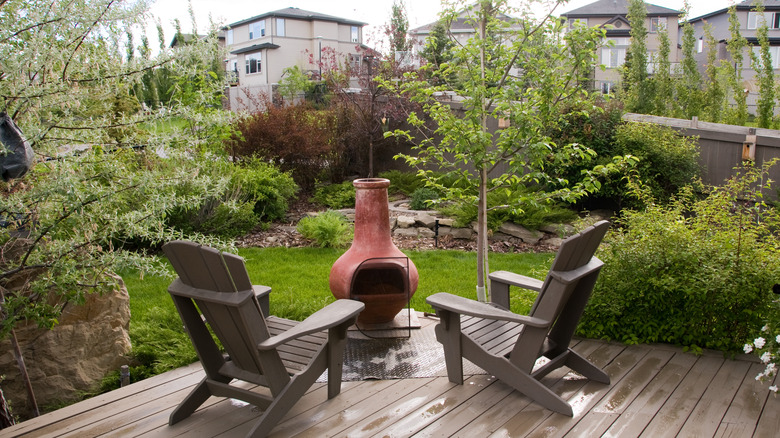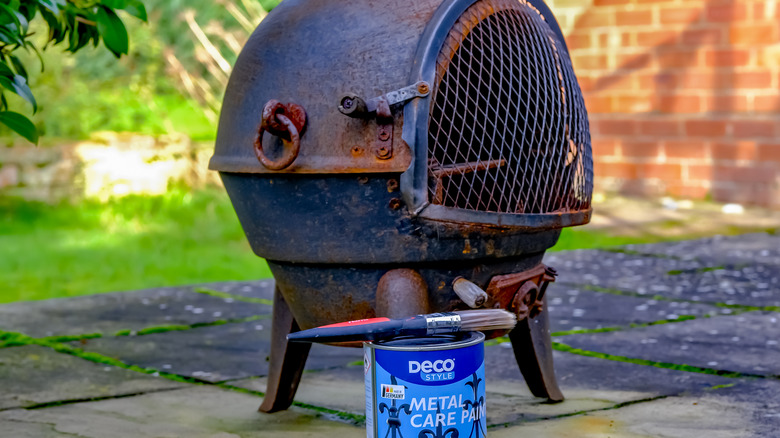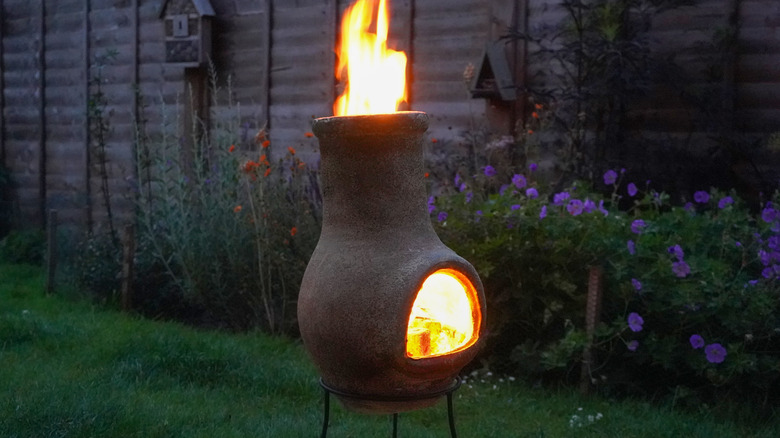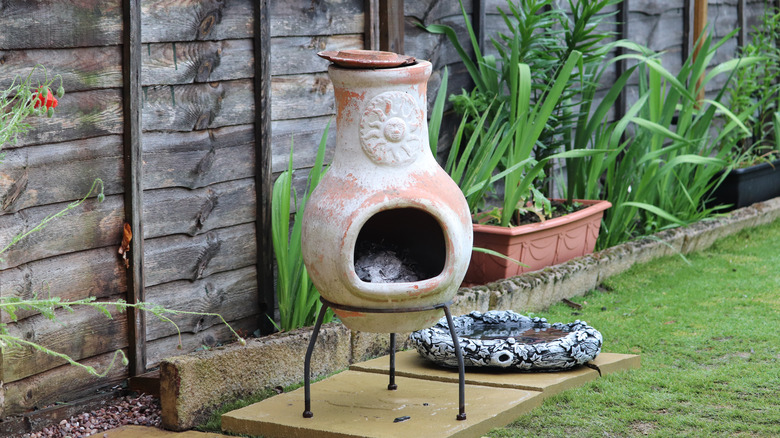What You Need To Know About Chimineas
Prepping your home's outdoor space for activities during cold seasons begins by making it warm and cozy. With a chiminea, you don't have to stay cooped up indoors during cold spring months. This freestanding fireplace is a solution that not only makes the outdoor patio warm but also adds flair and character to a space. Chimineas are essentially outdoor wood stoves with a long chimney and signature potbelly.
This design is to make sure that rainwater doesn't extinguish the flames of the chiminea. Although originally from Mexico, chimineas are popular across the U.S. and used for outdoor decoration, cooking, and also making a specific spot warm and cozy (via The Oklahoman).
Originally, chimineas were made from clay; however, modern designs make use of cast iron or cast aluminum, making them more efficient. There are plenty of designs today to suit any outdoor decor. If you want to know more about this outdoor fire feature, stick around!
Do you need to own a chiminea?
Well, let's put it this way, chimineas are one of those things that you never knew you needed until you have one. Setting this outdoor stove on your patio, or deck will have you question how you have been surviving without one. A chiminea is a versatile and portable item that not only serves as a cooking stove but also as an outdoor design detail. The beautiful Mexican mosaic patterns and colors featured on many chimineas will look amazing on your patio.
The Chiminea Guy mentions that there are gas-powered options that you can also use inside the house. Chimineas give you the central location where friends and family can gather around a fire and have great conversations. Think about roasting marshmallows with friends and family gathered around a warm mesmerizing fire.
While outdoor patios or decks are typically only useful during the warmer seasons, a chiminea can extend the useful months of your outdoor space.
Setting up your chiminea outdoors
Setting up a chiminea will require you to observe the basic principles that you would do when lighting up a fire pit. First off, you need to make sure the chiminea is on a level flat surface to avoid the risk of it toppling over. Another important consideration that you should keep in mind is to make sure it's standing on a heat-resistant or fireproof surface of the patio or deck; for instance, bricks or concrete pavers.
Deliberately position the chiminea in an open space away from anything that could catch fire. Also, this location should be visible from the house, allowing you to monitor the chiminea from a distance. A flaming chiminea should never be left unsupervised. The Pottery Patch advises you should gradually start with a small fire just to warm up the chiminea. This is especially true during the colder seasons when clay chimineas are likely to crack because of thermal shock.
Maintaining chimineas
Extreme weather conditions are the biggest enemy for chimineas. Regardless of the material, how you protect your chiminea from extreme weather conditions will determine how long it will serve. Chimineas are freestanding and portable, and one way of keeping them away from extreme conditions is moving yours indoors if necessary.
Clay chimineas' biggest enemy is water, so you should ask if the chiminea is coated with a waterproof sealant before buying. If your unsealed chiminea absorbs water by any chance, the best course of action is to bring it inside and allow it to dry out naturally, per Esbenshade's Garden Center.
Remember, if the absorbed water is not left to dry, it might freeze and cause cracking, especially during winter. According to Firewood for Life, you'll need to reseal your clay chiminea after three to six months, depending on the frequency of use. A rule of thumb, before lighting up a fire in the chiminea, be sure to add up to 4 inches of gravel or lava rock to protect the inside clay surface.
Chimineas or firepit?
Chimineas and firepits create a central location where family and friends can gather around for a good time. However, why should you have a chiminea instead of a firepit? First, chimineas are relatively safer than fire pits, per Chiminea Guy. Flames burn inside a controlled environment eliminating the risk of sparks that are common with fire pits. You don't have to worry about stray embers and focus more on the conversations with friends. The chiminea's design with an air opening in front and a long stack directs smoke away from those gathering around the fire.
This goes a long way in making the space comfortable for your guests. A fire pit, on the other hand, produces enough heat because of the larger flame as compared to chimineas (via Backyard Boss). Nonetheless, for most chiminea fans, safety and aesthetics are more important than the authentic dancing flames of the fire pit. People of all ages can enjoy the warmth around a chiminea.
How to choose the right chiminea
Well, there's no doubt that chimineas are a delight to the eyes. But before plunging ahead, you need to know where exactly to position your chiminea. This will inform your choice of material.
If you plan to place the chiminea under a shaded patio, then a clay chiminea will do just fine. However, consider other chiminea material, like cast iron, if your patio doesn't have a shade. Before settling on any chiminea, consider the material and your particular patio or deck setup.
GrowerExperts.com explains that high-quality clay chimineas are made of El Barro or Terracotta clay. Cheaper options typically don't last as long by comparison; therefore, a likely lower return on your money in the long run.
You also will need to consult the rules and regulations for chimineas and fire pits in your location. If wood-burning is against the law, you have no choice but to go for chiminea models that use liquid propane or gas as fuel alternatives.
